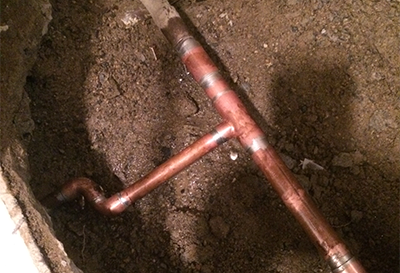Finding Hidden Water Line Leaks: Six Practical Detection Tricks
Finding Hidden Water Line Leaks: Six Practical Detection Tricks
Blog Article
We've come across this post involving Hacks to detect leaks listed below on the internet and concluded it made sense to share it with you over here.

Early discovery of dripping water lines can mitigate a prospective calamity. Some little water leaks may not be visible.
1. Take A Look At the Water Meter
Inspecting it is a guaranteed way that aids you find leakages. If it moves, that suggests a fast-moving leak. This indicates you may have a slow-moving leakage that might also be below ground.
2. Inspect Water Usage
If you detect abrupt changes, in spite of your consumption being the very same, it suggests that you have leaks in your plumbing system. An abrupt spike in your expense indicates a fast-moving leak.
A constant boost every month, even with the same routines, reveals you have a slow-moving leakage that's additionally slowly escalating. Call a plumber to thoroughly inspect your home, particularly if you feel a warm location on your flooring with piping beneath.
3. Do a Food Coloring Test
30% comes from commodes when it comes to water usage. Test to see if they are running properly. Decline flecks of food shade in the storage tank as well as wait 10 minutes. There's a leak between the storage tank and bowl if the shade somehow infiltrates your bowl throughout that time without flushing.
4. Asses Exterior Lines
Do not forget to examine your outdoor water lines too. Ought to water permeate out of the connection, you have a loosened rubber gasket. One little leakage can throw away tons of water as well as spike your water costs.
5. Check and also Evaluate the Circumstance
House owners need to make it a practice to check under the sink counters and even inside closets for any kind of bad odor or mold growth. These 2 red flags show a leakage so punctual attention is called for. Doing routine inspections, even bi-annually, can save you from a significant issue.
Check for discolorations and also compromising as a lot of pipelines and appliances have a life expectations. If you presume leaking water lines in your plumbing system, don't wait for it to rise.
Early detection of dripping water lines can alleviate a potential catastrophe. Some little water leaks might not be visible. Examining it is a surefire way that assists you find leakages. One tiny leak can squander bunches of water and surge your water expense.
If you think dripping water lines in your plumbing system, do not wait for it to rise.
How to Know If Your Home Has a Hidden Leak
Water Meter Reveals Inexplicable Water Usage
If you’d like to test whether or not there’s a leak somewhere in your home, you can do this using your water meter. Here is how to conduct the test:
Don’t use any water in your home for at least 30 minutes; this also means not turning on faucets or water-using appliances.
Go outside, and check your water meter for activity.
If your water meter shows that there was activity, even though no one was using any water, this proves that there is a leak in your home.Visible Mold or Mildew Growth
Leaks behind walls create moist, dark environments that allow mold and mildew to grow and thrive. Eventually, you might see mold growth forming on the wall closest to a hidden leak.
If mold is growing in an area that receives a high amount of moisture, such as a bathroom, it may simply be an indication that better ventilation is needed. However, if you see mold growth on a wall or the ceiling in an area where you would not expect, you probably have a hidden leak.
Musty, Mildew Odor
Sometimes you might not be able to see the mold or mildew that is growing as a result of a leak. However, the smell can give the problem away just as easily. If you catch a whiff of something musty, there’s a good chance that old water is collecting somewhere in your home that you can’t see.
Stained/Warped Walls, Ceilings, or Floors
When your home soaks up water, a variety of red flags can become visible, including ceiling stains, bubbling drywall, warped walls, and sagging floors. While these issues can be caused by excess humidity, they can also be signs that a pipe or plumbing connection has started leaking behind your walls.
Inexplicably High Water Bill
After a while, you get a general sense for what your water bill should be. If you own a pool or sprinkler system, your bill will tend to be higher during summer. However, if you receive a water bill that seems especially high, and you can’t figure out what caused it, then you may have a hidden leak somewhere that’s increasing your bill.
https://www.plumbingjoint.com/blog/2019/july/how-to-know-if-your-home-has-a-hidden-leak/

As a keen person who reads about Detecting hidden plumbing leaks, I was thinking sharing that article was important. Feel free to take the time to promote this write-up if you enjoyed it. We enjoy reading our article about Detecting hidden plumbing leaks.
Details Report this page